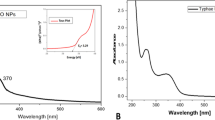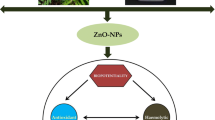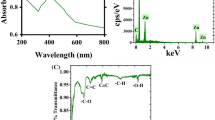Abstract
Copper nanoparticles were synthesized using Rhus punjabensis leaf extract and assessed for toxicity in vitro against brine shrimp Leishmania tropica and in vivo against Sprague–Dawley rats. The spherical biofunctionalized nanoparticles showed concentration and time-dependent toxicity during in vitro assays. Biocompatibility assessed against Sprague–Dawley rats at 50 and 100 mg/kg (low and high dose) depicted significant variation only in total bilirubin, alanine transaminase, and alkaline phosphatase in both male and female rats at both dose administration; however, non-significant change was recorded on other parameters. Antioxidative enzymes, total proteins, and nitrites also showed significant variation from control in both genders. Histological study revealed alteration in liver, heart, and lungs of male rats on higher dose administration, while female rats on low-dose administration were found safer. The results show that R. punjabensis-mediated CuO nanoparticles are safe at low dose and its application can be expanded as effectual antimicrobial and anticancer agents for pharmaceutical applications.






Similar content being viewed by others
References
Nations, S., M. Wages, J. E. Canas, J. Maul, C. Theodorakis, and G. P. Cobb. 2011. “Acute effects of Fe2O3, TiO2, ZnO and CuO nanomaterials on Xenopus laevis.” Chemosphere 83(8): 1053-1061
Krug, H. F., & Wick, P. (2011). Nanotoxicology: An interdisciplinary challenge. Angewandte Chemie International Edition, 50(6), 1260–1278. https://doi.org/10.1002/anie.201001037
Jiang, J., Oberdörster, G., Elder, A., Gelein, R., Mercer, P., & Biswas, P. (2008). “Does nanoparticle activity depend upon size and crystal phase? Nanotoxicology, 2(1), 33–42.
Oberdörster, G. (2010). Safety assessment for nanotechnology and nanomedicine: Concepts of nanotoxicology. Journal of internal medicine, 267(1), 89–105. https://doi.org/10.1111/j.1365-2796.2009.02187.x
Carlson, C., Hussain, S. M., Schrand, A. M., Braydich-Stolle, L. K., Hess, K. L., Jones, R. L., & Schlager, J. J. (2008). Unique cellular interaction of silver nanoparticles: Size-dependent generation of reactive oxygen species. The Journal of Physical Chemistry B, 112(43), 13608–13619. https://doi.org/10.1021/jp712087m
Karmali, P. P., & Simberg, D. (2011). Interactions of nanoparticles with plasma proteins: Implication on clearance and toxicity of drug delivery systems. Expert Opinion on Drug Delivery, 8(3), 343–357.
Mahmoudi, M., Hofmann, H., Rothen-Rutishauser, B., & Petri-Fink, A. (2012). Assessing the in vitro and in vivo toxicity of superparamagnetic iron oxide nanoparticles. Chemical Reviews, 112(4), 2323–2338. https://doi.org/10.1021/cr2002596
Fadeel, B., & Garcia-Bennett, A. E. (2010). Better safe than sorry: Understanding the toxicological properties of inorganic nanoparticles manufactured for biomedical applications. Advanced Drug Delivery Reviews, 62(3), 362–374.
Phull, A.-R., Abbas, Q., Ali, A., Raza, H., Zia, M., & Haq, I. U. (2016). Antioxidant, cytotoxic and antimicrobial activities of green synthesized silver nanoparticles from crude extract of Bergenia ciliata. Future Journal of Pharmaceutical Sciences, 2(1), 31–36.
Naz, S., Islam, M., Tabassum, S., Fernandes, N. F., de Blanco, E. J., & Zia, M. (2019). Green synthesis of hematite (α-Fe2O3) nanoparticles using Rhus punjabensis extract and their biomedical prospect in pathogenic diseases and cancer. Journal of Molecular Structure, 5(1185), 1–7.
Naz, S., Kazmi, S. T., & Zia, M. (2019). CeO2 nanoparticles synthesized through green chemistry are biocompatible: In vitro and in vivo assessment. Journal of Biochemical and Molecular Toxicology, 33(5), e22291. https://doi.org/10.1002/jbt.22291
Pradeep, A., & Chandrasekaran, G. (2006). FTIR study of Ni, Cu and Zn substituted nano-particles of MgFe2O4. Materials Letters, 60(3), 371–374.
Ren, G., Hu, D., Cheng, E. W., Vargas-Reus, M. A., Reip, P., & Allaker, R. P. (2009). Characterization of copper oxide nanoparticles for antimicrobial applications. International Journal of Antimicrobial Agents, 33(6), 587–590.
Henson, T. E., Navratilova, J., & Tennant, A. H. (2019). In vitro intestinal toxicity of copper oxide nanoparticles in rat and human cell models. Nanotoxicology, 13, 795–811.
Shi, M., Kwon, H. S., & Peng, Z. (2012). Effects of surface chemistry on the generation of reactive oxygen species by copper nanoparticles. ACS Nano, 6(3), 2157–2164.
Naz, S., Gul, A., & Zia, M. (2020). On the toxicity of copper oxide nanoparticles: A review study. IET Nanobiotechnology, 14(1), 1–13.
Naz, S., B. Nasir, H. Ali, and M. Zia. (2021). Comparative toxicity of green and chemically synthesized CuO NPs during pregnancy and lactation in rats and offspring: Part I-hepatotoxicity. Chemosphere, 266: 128945
Chang, Y. N., Zhang, M., & Xia, L. (2012). The toxic effects and mechanisms of CuO and ZnO nanoparticles. Materials. (Basel), 5(12), 2850–2871.
Ghareeb, M. A., Hussein, A. H., Hassan, M. F. M., Laila, A. R., Mona, A. M., & Amal, M. S. (2014). Antioxidant and cytotoxic activities of Tectona grandis linn. leaves. Internationl Journal Phytopharm, 5(2), 143–157.
Nithya, K., Yuvasree, P., & Neelakandeswari, N. (2014). Preparation and characterization of copper oxide nanoparticles. International Journal of Chemical Technology Research, 6, 2220–2222.
Jillani, S., M. Jelani, N. U. Hassan. (2018). Synthesis, characterization and biological studies of copper oxide nanostructures. Material Research Express 5, (4): 045006
Pantidos, N., & Horsfall, L. E. (2014). Biological synthesis of metallic nanoparticles by bacteria, fungi and plants. Journal of Nanomedicine and Nanotechnology, 05(5), 1.
Jefferson D. A. (2000). The surface activity of ultrafine particles’.Philosophical Transactions. Series A, Mathematical Physical, and Engineering Sciences 358, (1775): 2683 – 2692
Ilyas, M., & Basheer, C. (2015). Impact of nanoparticles on human and environment: Review of toxicity factors, exposures, control strategies, and future prospects. Environmental Science and Pollution Research, 22(6), 4122–4143.
Hillyer, J. F., & Albrecht, R. M. (2001). Gastrointestinal persorption and tissue distribution of differently sized colloidal gold nanoparticles. Journal of Pharmaceutical Science, 90(12), 1927–1936.
Wang, Z., Li, N., Zhao, J., White, J. C., Qu, P., & Xing, B. (2012). CuO nanoparticle interaction with human epithelial cells: Cellular uptake, location, export, and genotoxicity. Chemical research in toxicology, 25(7), 1512–1521.
Lee, I. C., Ko, J. W., Park, S. H., Lim, J. O., Shin, I. S., Moon, C., Kim, S. H., Heo, J. D., & Kim, J. C. (2016). Comparative toxicity and biodistribution of copper nanoparticles and cupric ions in rats. International Journal of Nanomedicine, 11, 2883.
Mohammadyari, A., Razavipour, S. T., Mohammadbeigi, M., Negahdary, M., & Ajdary, M. (2014). Explore in-vivo toxicity assessment of copper oxide nanoparticle in Wistar rats. Journal of Biology Today’s World, 3(6), 124–128.
Arafa, A. F., Ghanem, H. Z., Soliman, M. S., & EL-Meligy, E. (2017). Modulation effects of quercetin against copper oxide nanoparticles-induced liver toxicity in rats. Egyptian Pharmaceutical Journal, 16(2), 78–86.
Chen, H., Yoshioka, H., Kim, G. S., Jung, J. E., Okami, N., Sakata, H., Maier, C. M., Narasimhan, P., Goeders, C. E., & Chan, P. H. (2011). Oxidative stress in ischemic brain damage: Mechanisms of cell death and potential molecular targets for neuroprotection. Antioxidants & Redox Signaling, 14(8), 1505–1517.
Manna, P., Ghosh, M., Ghosh, J., Das, J., & Sil, P. C. (2012). Contribution of nano-copper particles to in vivo liver dysfunction and cellular damage: Role of IκBα/NF-κB, MAPKs and mitochondrial signal. Nanotoxicology, 6(1), 1–21.
Lee, I. C., Ko, J. W., Park, S. H., Shin, N. R., Shin, I. S., Moon, C., Kim, J. H., Kim, H. C., & Kim, J. C. (2016). Comparative toxicity and biodistribution assessments in rats following subchronic oral exposure to copper nanoparticles and microparticles. Particle and Fibre Toxicology, 13(1), 56–72.
Lei, R. C., Wu, B., Yang, H., Ma, C., Shi, Q., Wang, Q., Wang, Y., Yuan, M., & Liao, M. (2008). Integrated metabolomic analysis of the nano-sized copper particle-induced hepatotoxicity and nephrotoxicity in rats: A rapid in vivo screening method for nanotoxicity. Toxicology and Applied Pharmacology, 232(2), 292–301.
Ibrahim, M. A., Khalaf, A. A., Galal, M. K., Ogaly, H. A., & Hassan, A. H. (2015). Ameliorative influence of green tea extract on copper nanoparticle-induced hepatotoxicity in rats. Nanoscale Research Letters, 10(1), 1–9.
Naz, S., Nasir, B., Ali, H., Zia, M. (2021). Comparative toxicity of green and chemically synthesized CuO NPs during pregnancy and lactation in rats and offspring: Part I-hepatotoxicity. Chemosphere 266: 128945
Nasrullah, M., Gul, F. Z., Hanif, S., Mannan, A., Naz, S., Ali, J. S., & Zia, M. (2020). Green and chemical syntheses of CdO NPs: A comparative study for yield attributes, biological characteristics, and toxicity concerns. ACS Omega, 5(11), 5739–5747.
Gutteridge, J. M. (1995). Lipid peroxidation and antioxidants as biomarkers of tissue damage. Clinical Chemistry, 41(12), 1819–28.
Sarkar, A., Das, J., Manna, P., & Sil, P. C. (2011). Nano-copper induces oxidative stress and apoptosis in kidney via both extrinsic and intrinsic pathways. Toxicology, 290(2), 208–217.
Xu, P., Xu, J., Liu, S., & Yang, Z. (2012). Nano copper induced apoptosis in podocytes via increasing oxidative stress. Journal of Hazardous Materials, 241, 279–286.
Yang, B., Wang, Q., Lei, R., Wu, C., Shi, C., Wang, Q., Yuan, Y., et al. (2010). Systems toxicology used in nanotoxicology: Mechanistic insights into the hepatotoxicity of nano-copper particles from toxicogenomics. Journal of Nanoscience and Nanotechnology, 10(12), 8527–8537.
Liao, M., & Liu, H. (2012). Gene expression profiling of nephrotoxicity from copper nanoparticles in rats after repeated oral administration. Environmental Toxicology and Pharmacology, 34(1), 67–80.
Esterbauer, H., Schaur, R. J., & Zollner, H. (1991). Chemistry and biochemistry of 4-hydroxynonenal, malonaldehyde and related aldehydes. Free Radical Biology and Medicine, 11(1), 81–128.
Fatahian-Dehkordi, R., Reaisi, M., Heidarnejad, M. S., & Mohebbi, A. (2017). Serum biochemical status and morphological changes in mice ovary associated with copper oxide nanoparticles after thiamine therapy. Journal of Herbmed Pharmacology, 6(1), 21–26.
Song, M. F., Y. S. Li, H. Kasai, K. Kawai K. 2011. Metal nanoparticle-induced micronuclei and oxidative DNA damage in mice. Journal of clinical biochemistry and nutrition. 50(3): 211
Kung, M. L., Hsieh, S. L., Wu, C. C., Chu, T. H., Lin, Y. C., Yeh, B. W., & Hsieh, S. (2015). Enhanced reactive oxygen species overexpression by CuO nanoparticles in poorly differentiated hepatocellular carcinoma cells. Nanoscale, 7(5), 1820–1829.
Doudi, M., & Setorki, M. (2014). Acute effect of nano-copper on liver tissue and function in rat. Nanomedicine Journal, 1(5), 331–338.
Rodhe, Y., Skoglund, S., Wallinder, I. O., Potácová, Z., & Möller, L. (2015). Copper-based nanoparticles induce high toxicity in leukemic HL60 cells. Toxicology in vitro, 29(7), 1711–1719.
Wang, D., Lin, Z., Wang, T., Yao, Z., Qin, M., Zheng, S., & Lu, W. (2016). Where does the toxicity of metal oxide nanoparticles come from: The nanoparticles, the ions, or a combination of both? Journal of Hazardous Materials, 308, 328–34.
Yokohira, M., Kuno, T., Yamakawa, K., Hosokawa, K., Matsuda, Y., Hashimoto, N., Suzuki, S., Saoo, K., & Imaida, K. (2008). Lung toxicity of 16 fine particles on intratracheal instillation in a bioassay model using f344 male rats. Toxicologic Pathology, 36(4), 620–631.
Reddy, A. R. N., Colony, R. K., Pradesh, K. A., & Kumar, C. P. (2013). Pulmonary toxicity of copper oxide (CuO) nanoparticles in rats. Journal of Medical Sciences, 13(7), 571–577.
Chen, Z., Meng, H., Xing, G., Chen, C., Zhao, Y., Jia, G., Wang, T., et al. (2006). Acute Toxicological effects of copper nanoparticles in vivo. Toxicology letters, 163(2), 109–120.
El-Hussein, E. H. M. A., Abdel-Aziz, A., & El-Mehasseb, I. (2016). Effects of aluminum oxide (Al2O3) nanoparticles on ECG, myocardial inflammatory cytokines, redox state, and connexin 43 and lipid profile in rats: Possible cardioprotective effect of gallic acid. Canadian Journal of Physiology and Pharmacology, 94(08), 868–878.
Lei, R., Wu, C., & Yang, B. (2008). Integrated metabolomic analysis of the nano-sized copper particle-induced hepatotoxicity and nephrotoxicity in rats: A rapid in vivo screening method for nanotoxicity. Toxicology and Applied Pharmacology, 232(2), 292–301.
Wang, D., Lin, Z., & Wang, T. (2016). Where does the toxicity of metal oxide nanoparticles come from: The nanoparticles, the ions, or a combination of both? Journal of Hazardous Materials, 308, 328–334.
Meng, H., Chen, Z., & Xing, G. (2007). Ultrahigh reactivity provokes nanotoxicity: Explanation of oral toxicity of nano-copper particles. Toxicology Letters, 175(1–3), 102–110.
Rodhe, Y., Skoglund, S., & Wallinder, I. O. (2015). Copper-based nanoparticles induce high toxicity in leukemic HL60 cells. Toxicology in Vitro, 29(7), 1711–1719.
Author information
Authors and Affiliations
Corresponding author
Ethics declarations
Conflict of Interest
None.
Research Involving Humans and Animals Statement
None.
Ethical Statement
Animal study was carried out at the Primate Facility of Faculty of Biological Sciences, according to the National Institute of Health Guidelines. Approved protocol (Bch#0267) by the ethics committee of the Quaid-i-Azam University, Islamabad, Pakistan, was followed in this study.
Informed Consent
None.
Consent to Participate
All authors agreed to participate in this investigation.
Consent for Publication
All authors agreed to participate in this article.
Additional information
Publisher's Note
Springer Nature remains neutral with regard to jurisdictional claims in published maps and institutional affiliations.
Rights and permissions
About this article
Cite this article
Naz, S., Hanif, S., Ali, H. et al. Synthesis, Characterization, In Vitro and In Vivo Toxicity of CuO Nanoparticles Fabricated Through Rhus punjabensis Leaf Extract. BioNanoSci. 11, 946–956 (2021). https://doi.org/10.1007/s12668-021-00906-6
Accepted:
Published:
Issue Date:
DOI: https://doi.org/10.1007/s12668-021-00906-6




